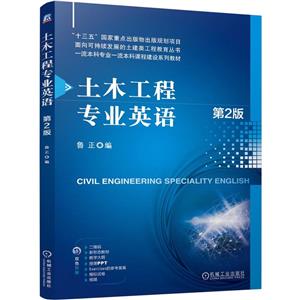Part 1Introduction to Civil EngineeringUnit 1Introduction to Reinforced Concrete Design1.1Concrete, Reinforced Concrete, and Prestressed Concrete1.2Structural Forms1.3Loads1.4Serviceability, Strength, and Structural Safety1.5Design BasisUnit 2Introduction to Prestressed Concrete2.1Introduction2.2Effects of Prestressing2.3Sources of Prestress Force2.4Prestressing Steels2.5Concrete for Prestressed ConstructionUnit 3Introduction to Steel StructuresPart 1Introduction to Civil EngineeringUnit 1Introduction to Reinforced Concrete Design1.1Concrete, Reinforced Concrete, and Prestressed Concrete1.2Structural Forms1.3Loads1.4Serviceability, Strength, and Structural Safety1.5Design BasisUnit 2Introduction to Prestressed Concrete2.1Introduction2.2Effects of Prestressing2.3Sources of Prestress Force2.4Prestressing Steels2.5Concrete for Prestressed ConstructionUnit 3Introduction to Steel Structures3.1Structural Design3.2Principles of Design3.3Historical Background of Steel Structures3.4Loads3.5Types of Structural Steel MembersUnit 4Seismic Design4.1Introduction4.2Structural Response4.3Seismic Loading CriteriaUnit 5Composite Construction5.1Overview5.2Pre-stressed Concrete Composite SlabsUnit 6Introduction to Foundation Analysis and Design6.1Foundations—Definition and Purpose6.2Foundation Classifications6.3Foundation Site and System Economics6.4General Requirements of Foundations6.5Foundation Selection6.6SI and Fps Units6.7Computational Accuracy Versus Design Precision土木工程专业英语第2版目录Unit 7Introduction to Other Branches of Civil Engineering7.1Bridge Engineering7.2Underground Engineering7.3Traffic Engineering7.4Hydraulic EngineeringPart 2New Material and New Development in Civil EngineeringUnit 8The Greening of Engineered Cementitious Composites8.1Introduction8.2ECC with Green Binder/Filler8.3ECC with Green Aggregate8.4ECC with Green Fibers8.5Summary and ConclusionsUnit 9Passive Base Isolation with Merits and Demerits Analysis9.1Introduction9.2Concept of Base Isolation9.3Base Isolation Systems9.4Merits and Demerits AnalysisUnit 10Supplemental Energy Dissipation: State-of-the-art and State-of-the-practice10.1Introduction10.2Basic Principles10.3Passive Energy Dissipation10.4Active,Hybrid and Semi-active Control Systems10.5Concluding RemarksUnit 11New Development Trend of Construction Industry11.1Intelligent Construction and Digital Industrial System11.2Prefabricated Building11.3Green Building11.4Resilient Urban and Rural AreasPart 3Project Management and Case StudyUnit 12Project Management and Administration12.1The Need for Project Management12.2Project Organization12.3The Project Manager12.4The Project Superintendent12.5Field Productivity12.6Project Administration12.7Project Meetings12.8Schedule of Owner Payments12.9Shop Drawings12.10Approval of the Shop Drawings12.11Quality Control12.12Expediting12.13Deliveries12.14ReceivingUnit 13Design and Construction of the Jin Mao Tower13.1The Structure System13.2Foundation Engineering13.3Wind Engineering13.4Earthquake Engineering13.5Unique Structural Engineering Solutions/On-site Structure Monitoring13.6ConclusionsUnit 14Design and Construction of the Burj Khalifa Tower14.1Introduction14.2Design and Construction14.3Impact and ReflectionsPart 4Scientific English Writing SkillsUnit 15Scientific English Writing Skills15.1科技英语的基本特点15.2科技论文的组成参考文献





















